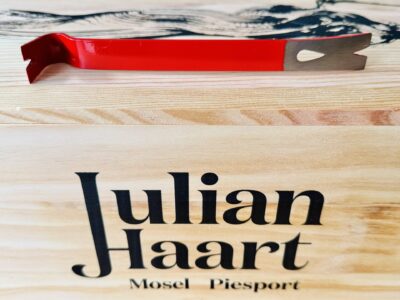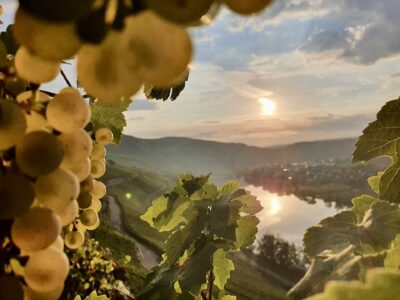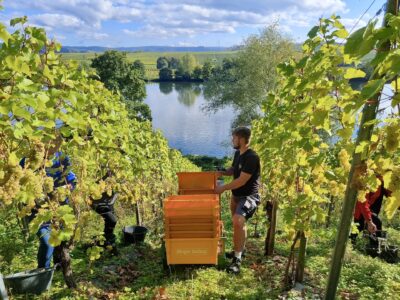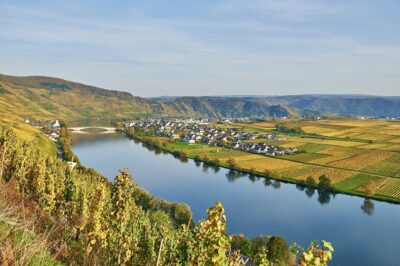The Kabi King from Piesport – Julian Haart and His Uncompromising Love for Riesling
 This year I was particularly excited about my allocation – for the first time I received a „Lagen Kiste“ from Julian Haart, the winemaker from Piesport on the Mosel who has since become known as the “Kabi King”. And from none other than the outstanding Kabinett vintage 2024.
This year I was particularly excited about my allocation – for the first time I received a „Lagen Kiste“ from Julian Haart, the winemaker from Piesport on the Mosel who has since become known as the “Kabi King”. And from none other than the outstanding Kabinett vintage 2024.
A little ritual accompanied the unboxing: a mini crowbar from Hultafors (190 mm). Perfect for cracking open the solid wooden case, pleasing to the eye and small enough to fit into any drawer. Presentation matters, after all.
From a 5,000-square-metre parcel to Mosel star
Julian Haart began in 2010 with just 5,000 square metres in the Wintricher Ohligsberg. Today, together with his wife Nadine, he cultivates five hectares – still a size that allows for uncompromising manual work in every vine row. Everything here is deliberately small-scale, precise and personal.
His path took him through some of the most illustrious names in German wine: Emrich-Schönleber, Heymann-Löwenstein, Egon Müller, and finally Klaus-Peter Keller, who also supported him in his first steps in Rheinhessen. Since 2018, Haart has been farming vineyards in Nieder-Flörsheim and, since 2022, in Mölsheim (Zellertal), including the Frauenberg and the legendary Zellerweg am Schwarzen Herrgott. Soils of limestone, loess and marl provide a striking counterpoint to the slate dominance of the Mosel.
 The vineyards – Mosel classics meet Rheinhessen limestone
The vineyards – Mosel classics meet Rheinhessen limestone
The core holdings remain on the Mosel:
– Wintricher Ohligsberg (1.4 ha, divided into three parcels, including a jewel of ungrafted vines planted in 1924)
– Piesporter Goldtröpfchen (c. 2 ha)
– Wintricher Großer Herrgott
– Piesporter Grafenberg
These are complemented by sites in Rheinhessen: Zellerweg am Schwarzen Herrgott and Nieder-Flörsheimer Frauenberg.
In addition to Riesling, he also grows Chardonnay and, on a tiny 0.4 ha, Pinot Noir – whose 2022 yields were reduced to a mere 9 hl/ha, making it more of a collector’s rarity than an everyday bottle.
Style – Kabinett as a royal discipline
Julian Haart has become known as the “Kabi King”. While others treat Kabinett as a by-product, he places this style centre stage. With a level of precision once reserved for Trockenbeerenauslese, he vinifies Kabinetts that combine elegance, drive and Mosel lightness.
His approach:
– spontaneous fermentation in traditional Mosel Fuder casks
– extended fine lees ageing for precision and depth
– sulphur addition mostly only at bottling
– uncompromising yield reduction (e.g. 35 hl/ha in 2022, just 9 hl/ha for Pinot Noir)
 The results speak for themselves: multiple 100-point scores from critics such as John Gilman and James Suckling (Stuart Pigott) – and as the youngest winemaker ever to achieve them. Historic, too, was the first-ever Kabinett to receive a perfect score.
The results speak for themselves: multiple 100-point scores from critics such as John Gilman and James Suckling (Stuart Pigott) – and as the youngest winemaker ever to achieve them. Historic, too, was the first-ever Kabinett to receive a perfect score.
White Label, vineyard cases & artist editions
In 2017, Haart introduced his White Label Kabinetts: cult wines that have become Instagram icons – few wine lovers resist posting a photo when they manage to secure a bottle. Only about 1,000 bottles are produced each year.
Even rarer is the bottling from the ungrafted Ohligsberg parcel planted in 1924, released with a special artist’s label by Anton Henning. Since 2019, these wines have only been available as part of the vineyard case – a wooden six-pack that also includes the dry “grand cru” wines.
Philosophy – “Nature is the boss”
Haart’s credo: “Nature is the boss” (source: Terroir & Adiletten, episode 85). He works with nature, not against it. This means:
– selective harvesting in multiple passes
– sustainable and responsible vineyard management
– uncompromising manual labour
– minimal intervention in the cellar
The result is wines that are unmistakably Mosel in character yet individually defined.
Looking ahead – sparkling wines and more
There is no standing still: from 2026 there will be the first sparkling wines – a Rosé and a Riesling Sekt from the 2021 vintage. And for those who thought Kabinett was the final playground: watch this space, as Haart may well set a new benchmark here too.
 Conclusion – a superstar redefining Kabinett
Conclusion – a superstar redefining Kabinett
The Haart family has been making wine in Piesport since 1337 – Julian represents the 30th generation. Critics such as John Gilman already see him as a superstar of German wine. Yet Haart himself remains focused on his clear goal: to craft high-end wines that bridge Mosel tradition and contemporary expression.
And for anyone who has ever had one of his Kabinetts in the glass, it becomes instantly clear: Kabinett can be world-class – if treated with the same seriousness as Julian Haart does.
Interview with Weingut Julian Haart
To round off, I had the opportunity to put a few short questions to Weingut Julian Haart. Their answers offer a fascinating glimpse into philosophy, enjoyment and what lies ahead.
1. At what age do you personally prefer to drink your Kabinetts and Spätlesen?
In fact, both young and old – that’s the beauty of these two Prädikat levels. The wines are captivating in their youthful freshness as well as in their maturity with added depth and complexity. We are always delighted when we have the chance to taste older vintages from fellow winemakers, and the wine is still vibrant after 20 or 30 years. That is our goal as well.
2. As a winemaker – and a cook – do you have a favourite wine and food pairing for your wines?
For us, fruity Rieslings pair wonderfully with spicy and aromatic cuisine – whether Asian, Indian or Chinese. We are great fans of this match, as it harmonises perfectly. But in general, we are open to culinary experiments and enjoy exploring dishes from around the world.
3. What new developments can we expect from Weingut Julian Haart?
In the coming years, we will be releasing our first Chardonnays. We plan to expand this variety, as it is more resilient and copes better with climate change than Riesling. In addition, next year will see our first sparkling wine: a Pinot Noir Sekt from the 2021 vintage, grown in the Wintrich vineyard.
My sincere thanks go to Weingut Julian Haart for answering my questions. The last three photos were kindly provided by the estate and are published here with their permission.
